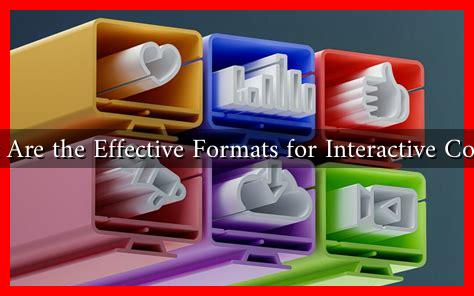-
Table of Contents
What Are the Effective Formats for Interactive Content
In the digital age, engaging users has become a paramount goal for marketers and content creators. Interactive content has emerged as a powerful tool to captivate audiences, enhance user experience, and drive conversions. This article explores the most effective formats for interactive content, providing insights into their benefits, examples, and best practices.
Understanding Interactive Content
Interactive content refers to any type of content that requires active participation from the user. Unlike traditional content, which is passive, interactive formats encourage users to engage, explore, and contribute. This engagement can lead to higher retention rates, increased brand loyalty, and improved conversion rates.
Effective Formats for Interactive Content
There are several formats of interactive content that have proven to be effective in engaging audiences. Here are some of the most popular:
- Quizzes and Polls: These formats allow users to express their opinions or test their knowledge. For example, BuzzFeed’s quizzes have become a cultural phenomenon, driving significant traffic and engagement.
- Interactive Infographics: Infographics are already a popular content format, but adding interactivity can enhance their effectiveness. Users can click on different sections to reveal more information, making the content more engaging.
- Calculators and Tools: Providing users with tools that help them solve problems or make decisions can be highly effective. For instance, mortgage calculators on real estate websites help users understand their financial options.
- Surveys: Surveys not only gather valuable data but also engage users by making them feel their opinions matter. Companies like SurveyMonkey have built entire platforms around this concept.
- Interactive Videos: Videos that allow users to choose their path or make decisions can significantly enhance engagement. Platforms like YouTube offer features that enable creators to add interactive elements to their videos.
Benefits of Interactive Content
Interactive content offers numerous advantages that can enhance marketing strategies:
- Increased Engagement: Interactive formats capture attention and encourage users to spend more time with the content.
- Higher Retention Rates: Users are more likely to remember information presented in an interactive format compared to static content.
- Enhanced User Experience: Providing users with a personalized experience can lead to greater satisfaction and loyalty.
- Valuable Data Collection: Interactive content can be a powerful tool for gathering insights about user preferences and behaviors.
Case Studies: Success Stories in Interactive Content
Several brands have successfully leveraged interactive content to achieve their marketing goals:
- Netflix: The streaming giant used interactive storytelling in its “Black Mirror: Bandersnatch” film, allowing viewers to make choices that influenced the plot. This innovative approach not only captivated audiences but also generated significant buzz on social media.
- National Geographic: Their interactive maps and quizzes engage users by providing immersive experiences that educate while entertaining. This approach has helped them maintain a strong online presence.
- HubSpot: The marketing platform offers a variety of interactive tools, including calculators and assessments, which help users understand their marketing needs while generating leads for the company.
Best Practices for Creating Interactive Content
To maximize the effectiveness of interactive content, consider the following best practices:
- Know Your Audience: Tailor your interactive content to meet the interests and needs of your target audience.
- Keep It Simple: Ensure that the interactive elements are easy to use and understand. Complicated interfaces can deter engagement.
- Incorporate Visuals: Use appealing visuals to enhance the interactive experience and make the content more engaging.
- Test and Optimize: Regularly analyze user engagement and feedback to refine your interactive content strategy.
Conclusion
Interactive content is a dynamic and effective way to engage audiences in today’s digital landscape. By utilizing formats such as quizzes, interactive infographics, and tools, brands can create memorable experiences that resonate with users. The benefits of increased engagement, higher retention rates, and valuable data collection make interactive content a vital component of any marketing strategy. As demonstrated by successful case studies, the right approach can lead to significant improvements in brand loyalty and conversion rates. Embracing interactive content is not just a trend; it is a necessity for brands looking to thrive in a competitive market.
For more insights on interactive content and its impact on marketing, visit Content Marketing Institute.

